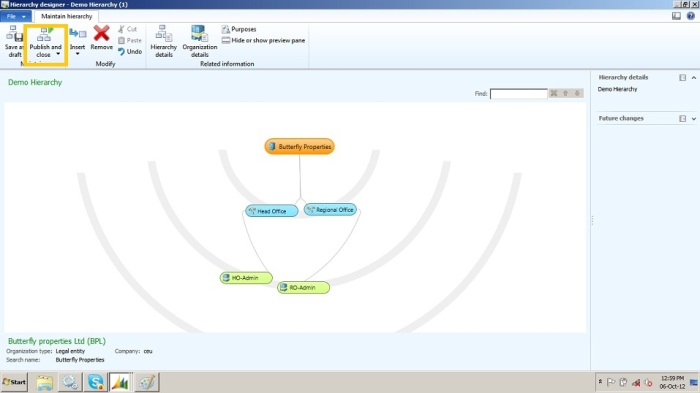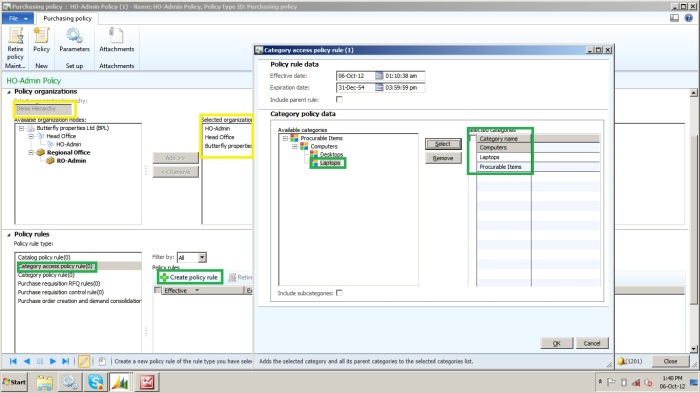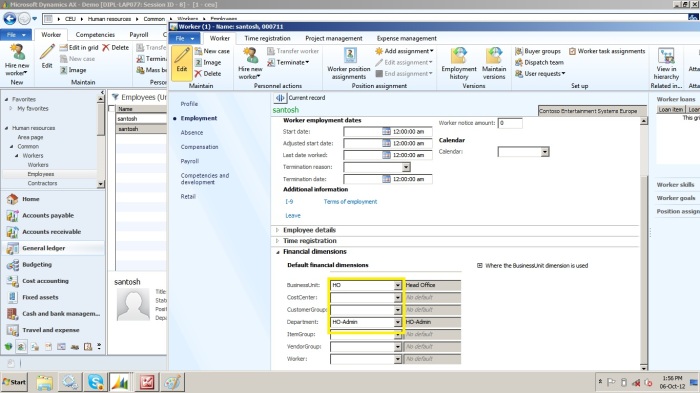Use a procurement category hierarchy to classify products that your
organization purchases for its own use. You can set policies for
ordering from categories in the hierarchy, create attributes for
categories, and assign vendors as preferred suppliers in a procurement
category. Only one active procurement category hierarchy can be defined
for an organization.
-
Click Product information management > Setup > Categories > Category hierarchies. On the Action Pane, in the New group, click Category hierarchy.
-
In the Create a category hierarchy form, enter a name and an optional description of the procurement category hierarchy, and then click Create.
-
In the Category hierarchy form, create a new category hierarchy. For more information about how to set up a category hierarchy.
-
Assign the category hierarchy to the Procurement category hierarchy type. For more information about category hierarchy types.
Use this procedure to assign product attributes to categories. All
products in a category have the same product attributes. When you assign
products to the category, you set up the values for product attributes.
Product attributes are displayed in the Employee services portal in
Enterprise Portal for Microsoft Dynamics AX.
For example, you assign the product attributes Installation and Warranty to a category. You set up the product attributes as Required. You assign the product Computer to the category, and set the value for both Installation and Warranty to Yes. When an employee orders a computer from the category, the employee sees that installation and warranty are included in the price of the laptop. For more information about product attributes.
For example, you assign the product attributes Installation and Warranty to a category. You set up the product attributes as Required. You assign the product Computer to the category, and set the value for both Installation and Warranty to Yes. When an employee orders a computer from the category, the employee sees that installation and warranty are included in the price of the laptop. For more information about product attributes.
-
Click Procurement and sourcing > Setup > Categories > Procurement categories.
-
In the Procurement categories: %1 form, select a category in the left pane, and then on the Product attributes FastTab, click Add.
-
In the Product attributes form, select the product attributes that you want to associate with the selected procurement category. Click Select ->, and then click OK.
-
On the Product attributes FastTab, select the characteristics for each product attribute. Select from the following options:
- Required – Select this check box to require a value for the product attribute for products that you assign to the category.
- Internal – Select this check box to specify whether the product attribute is displayed in Enterprise Portal.
- Searchable – Select this check box to include the product attribute in searches for product attributes in Enterprise Portal.
- Required – Select this check box to require a value for the product attribute for products that you assign to the category.
-
If the selected category is a subcategory, select the Inherit attributes from parent category: check box to assign the same product attributes to the subcategory that you assign to its parent category.
Use this procedure to assign products to categories.
-
Click Procurement and sourcing > Setup > Categories > Procurement categories.
-
In the Procurement categories: %1 form, select a category in the left pane, and then on the Products FastTab, click Add.
-
In the Add products form, select the products that you want to assign to the selected procurement category, click Select ->, and then click OK.
Use this procedure to add a vendor to a procurement category and to
specify whether a vendor is preferred in the category. When you delete a
vendor from a category, the historical transactions with the vendor in
the category are not deleted.
In the Employee services portal in Enterprise Portal, an employee can request to add a new vendor to a procurement category and to extend existing vendors to additional procurement categories. For more information about category requests.
In the Employee services portal in Enterprise Portal, an employee can request to add a new vendor to a procurement category and to extend existing vendors to additional procurement categories. For more information about category requests.
-
Click Procurement and sourcing > Setup > Categories > Procurement categories.
-
In the Procurement categories: %1 form, select a category in the left pane, and then on the Vendors FastTab, click Add.
-
In the Add vendors form, select the vendors that you want to assign to the procurement category, click Select ->, and then click OK.
-
To delete a selected vendor from the category, on the Vendors FastTab, click Remove.
-
Click Evaluation to open the Rating on vendor evaluation criteria form, where you can rate a vendor’s performance in the selected category.
 Note
Note Before you can evaluate a vendor, you must create vendor evaluation criterion groups and criteria, and then assign an evaluation criterion group to the category. For more information about how to set up and rate a vendor.
-
In the Vendor status field, select a status. By default, the vendor status is set to Approved. You can change the vendor status to Preferred,
and then set up a policy rule to require employees to order only from
preferred vendors.
-
Select the Inherit vendors from parent category:
check box to assign the same vendors to the selected subcategory that
you assign to its parent category. The approved or preferred status of a
vendor is also inherited.
Use this procedure to assign a questionnaire to a procurement
category. You can use questionnaires to understand a new vendor’s
business and products, and to determine the vendor’s ability to provide
products in a procurement category. When a vendor requests to do
business in a procurement category, you can require the vendor to
complete a questionnaire for that category.
-
Click Procurement and sourcing > Setup > Categories > Procurement categories.
-
In the Procurement categories: %1 form, select a category in the left pane, and then on the Questionnaires FastTab, click Add.
-
In the Add questionnaire form, select the questionnaire that you want to associate with the selected procurement category, click Select ->, and then click OK. The activity type describes the intent of the questionnaire.
-
To delete a questionnaire from a category, select the questionnaire, and then click Remove.
Use this procedure to enter values for category attributes. You assign
category attributes when you create a procurement category hierarchy in
the Category hierarchy form.
For example, you assign the category attribute Category contact to a category in the Procurement categories: %1 form. In the Category hierarchy form, you enter the name of the person to contact for questions about the procurement category. The name of the person is the value for the category attribute Category contact.
For example, you assign the category attribute Category contact to a category in the Procurement categories: %1 form. In the Category hierarchy form, you enter the name of the person to contact for questions about the procurement category. The name of the person is the value for the category attribute Category contact.
-
Click Procurement and sourcing > Setup > Categories > Procurement categories.
-
In the Procurement categories: %1 form, select a category in the left pane.
-
On the Category attribute values FastTab, select a category attribute. In the General section on the right side of the FastTab, in the Value: field, enter a value for the category attribute for the type indicated. Examples of value types are Text, Currency, Boolean, Decimal, and Integer.
-
To translate a value into another language, click the button on the right side of the Value: field.
-
To clear a value from a category attribute, click Reset value.
Use this procedure to add a category page to a procurement category. You can create category pages in the Category hierarchy
form. A category page contains information about the procurement
category. Examples of this information include information about the
type of products in a category, images of products in a category, and
announcements such as sales or discounts that are available in a
category. Category pages are displayed in the Employee services portal
in Enterprise Portal.
-
Click Procurement and sourcing > Setup > Categories > Procurement categories.
-
In the Procurement categories: %1 form, select a category in the left pane.
-
On the Category page FastTab, in the Category page:
field, select the category page that you want to display in Enterprise
Portal for the selected procurement category. The selected category page
is displayed on the Category page FastTab so that you can review the page.























